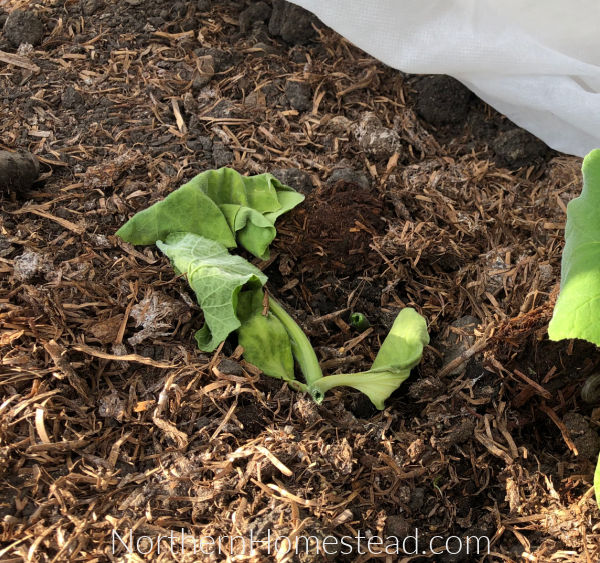
A garden is always shared with many organisms, wanted and unwanted. Most of them we are not even aware of. However, a cutworm in the vegetable garden will make itself known in a quite unpleasant way.
We do not suggest starting a war on cutworms, neither to hate nor despise them. They are just trying to eat their way through life, very much like everybody else. It just so happens that their eating habit is destructive to the vegetable garden. This article is meant to help to be aware of them and to find ways to protect the plants we want to keep from them.
What is a cutworm

A cutworm is a moth larva from different species of night-flying moths. Like their parents, they usually come out at night to feed on plants. A larva typically attacks the first part of the plant it comes across, most often it is the stem of a seedling, and cuts it down. No, they do not consume what they have just cut down, they just move to the next plant. That’s why a cutworm is called a cutworm.

Cutworms come in different colors, from light to green to brown just as their flying moth parents. The easiest way to identify them is by their rolled-up form. But don’t get fooled, they look very much like a caterpillar when scrolling around.
Moths lay their eggs in late summer or fall, the eggs usually overwinter and hatch in May or June when the soil warms up. Other species overwinter as larva.
How to avoid cutworms
It is a good idea for the home vegetable garden to remove any caterpillar or pupa that you come across and look suspicious before they become moths. Look for larva in spring and orange pupa in summer.

The larva will not be visible during the day, but an early morning walk through the garden can show you traces of their presence. If you see anything cut off, or nagged on chances are there is a cutworm. If a plant looks weakened, check the stem, depending on what it is it might not be cut down in one go. Usually, you will not have to look far, just a few inches from the cut, the larva will lay in the soil resting and waiting for the next night to continue to eat aka cut off more from the plant or kill it completely.
Moths lay their eggs directly on the soil. To till the soil in autumn and spring helps to kill them, but also alongside all the good worms. We use a no-till gardening method where we mulch the soil instead of tilling it.
There is mixed information about cutworms and mulch. In theory, it should eliminate cutworms altogether since there is no soil to lay eggs on. However, some gardeners find that mulch applied in autumn or spring has created major cutworm issues for them. In our garden, I must admit, that we have seen an increased population with switching from woodchip mulch to compost mulch. However, it usually is the bed that was not mulched, that has a bigger problem. We would like to hear about your experience.
Protecting plants from cut warms
Cutworms will attack any plant they come across. However, I find that cabbage plants and squash/cucumbers are most vulnerable to cutworms. But, I have seen them attacking a flower, too.

To protect plants you can place a collar around the seed or young seedling before planting. Or if it is an older seedling like a tomato, around the stem of the plant.
The protection should be about an inch into the soil and an inch above it.

A cut-open thin can, a plastic container, or even a toilet paper roll can work.

Just to place a nail or stick next to the stem does not help, the cutworm just starts at the other side, as you see here with the squash plant. Using a few from all sides could work though.
Other options are cut open plastic straw or anything that can go around the stem and expend with it as not to hinder the plant in growth.
We would love to hear from you? How do you protect plants from cutworms? Please share in a comment below.
We invite you to subscribe to Northern Homestead and follow us on Facebook, Instagram, or Pinterest for the latest updates.












What about using eggshells around the plants and DE dusting?
Sprinkle cornmeal on soil surface in early Spring & around young plants a few times during the season & after a rain. They love it but cannot digest it. Re the compost debate, I once found hundreds of cutworms under a pile of weeds which I tossed onto a clean bed & left for a week- this was before I discovered the cornmeal trick.
After decades of battling cutworms in my organic gardens, finally found that sprinkling cornmeal on the soil in early Spring really works. They are attracted to it but cannot digest it. Do this every year, & repeat a few times, sprinkling around young plants, during the growing season. Re the compost debate, I once piled the weeds from one bed onto a recently weeded bed, where they sat for 3 or 4 days. When I got around to raking them up for the compost bin, I found hundreds of cutworms in a 4’x6′ area!
Thank you for sharing your experience. Wondering if the cutworms were attracted to the weeds and came from far and wide. That would make a good trap for them.